Pivot Mach 6 Carbon - Reviewed
Pivot’s Mach 6 Carbon joined the increasingly popular long-travel all-mountain / trail bike niche towards the end of 2013, and it is unique to their range in that it was designed from the beginning to be a carbon fiber chassis, built around 27.5-inch wheels. Every aspect of the 155 millimeter travel (six inches) frame is optimized for strength and stiffness by using large diameter tubes all ‘round, and voluminous profiling at the bottom bracket and head tube areas. Medium-sized frames, with the shock, reportedly weigh only six pounds (6.27 with the Float-X shock). Like all Pivot dual-suspension bikes, the Mach 6 Carbon employs a dual-rocker four-bar linkage, but this time suspension designer Dave Weagle moderated the pronounced anti-squat function to be more suitable for the smaller chainrings that most riders prefer.The result is more of the bottomless feel that in the rear suspension that most all-mountain and technical trail riders prefer. Backing up its suspension, the Mach 6’s numbers are where they should be; slack enough up front to shred the downs and with ample breathing room in the cockpit for hammering the climbs. Optimizing the design of the Mach 6 for carbon also resulted in the sharpest looking dual-suspension bike that Pivot has made to date. Five sizes are available from X-small through X-large, and Pivot offers seven builds ranging from $4699, to $7599, including Shimano SLX, XT, XT/XTR and XTR, as well as SRAM X9, XO-1 and XX1 components. Our medium-sized test bike, outfitted with the Shimano XTR/XT build and a dropper seatpost, weighed 28.47 pounds (12.94kg), and comes with an MSRP of $6099 USD.
Mach 6 XTR/XT Build
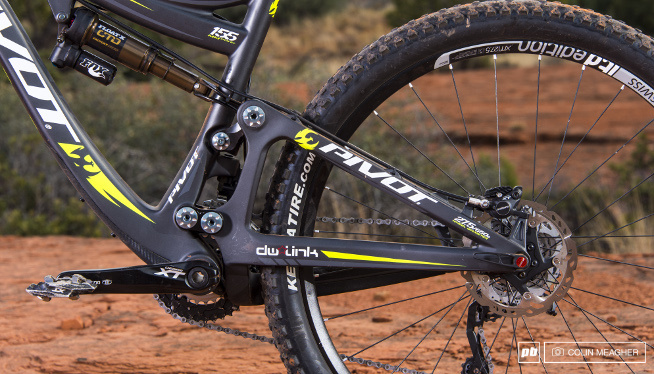
| Specifications | ||
| Release Date | 2013 | |
| Price | $6099 | |
| Travel | 155mm | |
| Rear Shock | Fox Factory Float X, Kashima, custom tune | |
| Fork | Fox Factory 34 Trail Adjust, Kashima 150mm | |
| Headset | Pivot | |
| Cassette | Shimano HG-81, 11 x 36, 10-spd | |
| Crankarms | Shimano XT, 24 x 38 | |
| Chainguide | NA | |
| Bottom Bracket | Shimano PressFit 92mm | |
| Pedals | NA | |
| Rear Derailleur | Shimano XTR | |
| Chain | Shimano XT | |
| Front Derailleur | Shimano XT | |
| Shifter Pods | Shimano XT | |
| Handlebar | Phoenix Carbon 740mm | |
| Stem | FSA SL-K, 60mm | |
| Grips | Pivot lock-on | |
| Brakes | Shimano XT, ICE rotors and pads, 160mm (R), 180mm (F) | |
| Wheelset | DT Swiss 350 spline One XM, 27.5" | |
| Hubs | DT Swiss 350, straight pull | |
| Spokes | DT Swiss Competition S-pull | |
| Rim | DT Swiss, XM | |
| Tires | Kenda 27.5 x 2.2" Honey Badger (R), 2.35" Nevegal II (F) | |
| Seat | WTB Vigo Race, Pivot Logo | |
| Seatpost | KS LEV dropper | |
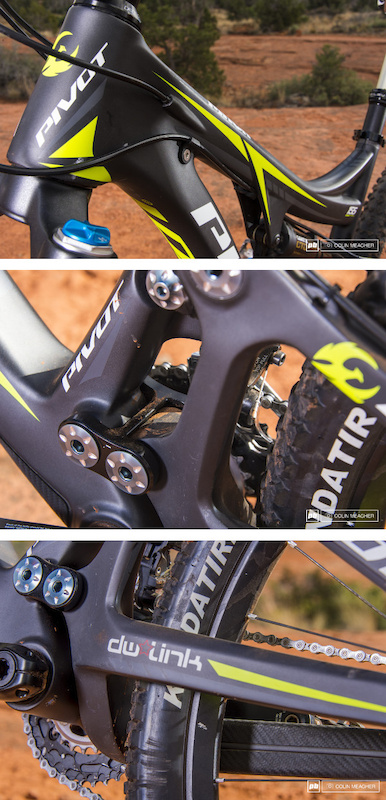
 (Top) Flush-type headset cups maximize the area of the head
(Top) Flush-type headset cups maximize the area of the headtube junction without adding height to the handlebar controls.
Forged-aluminum rockers rotate on double-row Enduro Max
ball bearings. The use of a 92-millimeter-wide PressFit bottom
bracket provides the maximum width to stiffen the frame there.
The asymmetrical swingarm is a convincing argument for carbon.
Construction Notes
Pivot’s Carbon frames are made in Asia, by a relatively small factory that limits its production to making elite level frames and components for a handful of lucky brands. The carbon comes primarily from Toray of Japan, and the molding process used in their construction is just finding its way into the most elite-level factories. While the choice of carbon material defines the best from the rest, getting the layers of carbon fibers aligned exactly in the correct orientation and then squeezing them together evenly and with sufficient pressure is of even greater consequence if the goal is to make the lightest, strongest and most reliable structure.
The Mach 6 frame begins with a stiff plastic shell, molded to the final shape of the part. Layers of carbon are applied to the rigid shell, which fits the steel mold perfectly, so when the mold is pressurized and heated, the carbon layers remain in place while the resin first liquefies, and then catalyzes to its final hardness. Like all monocoque molded carbon structures, the internal pressure is applied with an inflatable bladder, but in the case of the Mach 6, the bladder pressurizes the semi-rigid shell, which in turn squeezes and cures the layers inside the mold with better compaction - and also provides little or no chance for the fibers to migrate from their planned orientation when the carbon matrix is in the slippery, liquefied stage. Essentially, each frame requires two sets of molds: one set to make the semi rigid plastic mandrels and another set to produce the finished parts.
What this means to riders, is that the Mach 6 is light enough to be ridden like a trail bike, laterally rigid to the point where it can hold its line through the scary stuff like a DH sled, and it can take a beating in the hands of a rider who is willing to pay for the price of progression in his or her own flesh and blood. It also means that both the inside and the outside of the Mach 6 frame emerge from the molds in near-finished condition, so all the important bits, like its tapered headset, PressFit bottom bracket, the suspension rocker bearings, even the seatpost, fit just right, every time.
Aesthetics are important to Pivot, but not to the degree that Chris Cocalis will let good looks get in the way of proper suspension placement and frame-strength properties. Some have criticized the curving braces, bulbous bottom bracket forgings and grotesquely offset linkages that the designer has employed in the past to sneak away the last few grams of weight, or to add a handful of Newtons to the torsional stiffness of his welded-aluminum frames. The Mach 6, however, takes full advantage of carbon’s exceptional strength and its molded construction to transcend the limitations of aluminum.
Pivot’s Carbon frames are made in Asia, by a relatively small factory that limits its production to making elite level frames and components for a handful of lucky brands. The carbon comes primarily from Toray of Japan, and the molding process used in their construction is just finding its way into the most elite-level factories. While the choice of carbon material defines the best from the rest, getting the layers of carbon fibers aligned exactly in the correct orientation and then squeezing them together evenly and with sufficient pressure is of even greater consequence if the goal is to make the lightest, strongest and most reliable structure.
 | The Mach 6 traces a similar profile as its predecessors, but with well-formed lines and refreshing simplicity. |
The Mach 6 frame begins with a stiff plastic shell, molded to the final shape of the part. Layers of carbon are applied to the rigid shell, which fits the steel mold perfectly, so when the mold is pressurized and heated, the carbon layers remain in place while the resin first liquefies, and then catalyzes to its final hardness. Like all monocoque molded carbon structures, the internal pressure is applied with an inflatable bladder, but in the case of the Mach 6, the bladder pressurizes the semi-rigid shell, which in turn squeezes and cures the layers inside the mold with better compaction - and also provides little or no chance for the fibers to migrate from their planned orientation when the carbon matrix is in the slippery, liquefied stage. Essentially, each frame requires two sets of molds: one set to make the semi rigid plastic mandrels and another set to produce the finished parts.
What this means to riders, is that the Mach 6 is light enough to be ridden like a trail bike, laterally rigid to the point where it can hold its line through the scary stuff like a DH sled, and it can take a beating in the hands of a rider who is willing to pay for the price of progression in his or her own flesh and blood. It also means that both the inside and the outside of the Mach 6 frame emerge from the molds in near-finished condition, so all the important bits, like its tapered headset, PressFit bottom bracket, the suspension rocker bearings, even the seatpost, fit just right, every time.
Aesthetics are important to Pivot, but not to the degree that Chris Cocalis will let good looks get in the way of proper suspension placement and frame-strength properties. Some have criticized the curving braces, bulbous bottom bracket forgings and grotesquely offset linkages that the designer has employed in the past to sneak away the last few grams of weight, or to add a handful of Newtons to the torsional stiffness of his welded-aluminum frames. The Mach 6, however, takes full advantage of carbon’s exceptional strength and its molded construction to transcend the limitations of aluminum.
The Mach 6 traces a similar profile as its predecessors, but with well-formed lines and refreshing simplicity. The lower brace for its asymmetrical swingarm, for instance, adopts a rectangular profile to maintain the greatest cross-section while arcing around the tire to maximize mud clearance. Indentations blend the transition where upper rocker link meets the front section of the frame, while keeping the seat tube’s profile as wide as possible for pedaling stiffness. Rubberized leather frame protectors are bonded into molded recessions in the right-side swingarm and the downtube. External cable guides are faired into the frame and the lines for the shifters and dropper seatpost are routed internally. It’s a sweet looking bike.
Suspension Details
Pivot has a longstanding relationship with Fox Suspension, so it comes as no surprise that our Mach 6 was outfitted with the Float X reservoir shock and a 150-millimeter-stroke Float 34 CTD Kashima fork. Like most high-end mountain bikes, the Mach 6’s shock is custom-tuned to match the unique leverage curves of its dw-link suspension. The fork, however, was reported by Pivot to be an off-the-shelf factory tune – a notion that had us concerned that it would duplicate the mushy performance of earlier Fox CTD sliders. As testing progressed, though, it became clear that Fox had put those issues to rest. Pivot says that the Mach 6 is suitable for forks with 150-160 millimeters of travel.
 | The new Mach 6 strikes a better balance, with a lower, more stable feeling ride height, and with pedaling that remains just firm enough to accelerate and climb with the shock's pedaling aids switched off. |
Cocalis stated, in a discussion about the Mach 6 Carbon’s revamped dw-link suspension curves, that shock makers put the external suspension adjustments on there for a reason and that the slightly reduced anti-squat in the suspension provides riders with more tuning options and a suppler, deeper-feeling suspension action. “Anti-squat” is configured into the suspension geometry to counter the tendency of the rider’s mass to lag behind and compress the rear suspension with each acceleration of the pedals. Previous Pivot designs used a lot, which earned them a reputation for being excellent climbers with the suspension set wide open. The negative side of all that anti-squat was that the suspension was hyper sensitive to spring pressure and compression damping changes. The new Mach 6 strikes a better balance, with a lower, more stable feeling ride height, and with pedaling that remains just firm enough to accelerate and climb with the shock’s pedaling aids switched off. With the Float X’s CTD low-speed-compression lever set in the middle position, pedaling is as firm as anyone needs, except for a fussy XC racer, leaving the maximum platform option available for road rides and such.
Physically, the Mach 6 rear suspension differs from some designs, because it uses a yoke extension adapted to the shock to place the damper in a better position in the frame, as well as to moderate the beginning and end-stroke changes in the suspension’s leverage-rate curves. Pivot’s design does not require a custom shock, which is good news, because the nature of the beast suggests that many Mach 6 owners will want the option to switch out their shocks to coil-over types, or the damper of the moment. The business end of the yoke simply fits into the existing shock eyelet. As mentioned earlier in the text, Pivot installs double-row sealed ball bearings in the highly stressed rocker links, while single-row bearings are used in the yoke assembly.
Component Shout-Outs
Our build differed from the stated components in a few respects. Both tires were Kenda’s 2.2-inch Honey Badgers, which seemed under-gunned for a bike in the AM/enduro arena (a more aggressive, 2.3-inch Nevegal II is standard spec up front). Happily, the seatpost was upgraded to the KS LEV Integra dropper option. The stem was an FSA Gravity model, which was better suited to the bike than the SLK, which is normally spec'ed. Further highlights include DT Swiss XM 27.5 350 tubeless wheels. The 27-millimeter outside and 22.5-millimeter inside dimensions are more than adequate for aggressive riding, although we'd like to see wider rims in the future. The carbon, 740-millimeter Pivot Phoenix riser bar had a natural feeling bend and sweep-back angle, and the WTB Vigo Race saddle was also remarkably comfortable. For the drivetrain, Pivot chose a Shimano XT two-ring crankset with a sensible. 38 x 24-tooth gear ratio. The direct-mount front derailleur was also an XT item, while the rear mech' is a clutch-type long-cage XTR Shadow Plus model. If you are going to ride a two-by ten with 26 or 27.5-inch wheels, this is probably one of the better gearing choices. All totaled, our Mach 6 Carbon was well appointed, but decidedly on the lighter side of the all-mountain spectrum.
 | The Mach 6 feels lower and more capable than any Pivot we have ridden, but none of that seems to come at the expense of its agile feel in the steering department. |
Some bikes feel familiar after a few rides, but the really good ones feel as if you have owned them for a year after only a dozen pedal strokes. The Mach 6 Carbon is an easy ride in all respects. It isn’t overly sensitive to suspension setups and it requires very little from its pilot to negotiate technical terrain. When a bike clicks with its rider like the Mach 6 does, the legs feel fresher, the mind is sharper and the body stays more relaxed. It probably helped that the first ride on the Pivot took place after a light rain and any soil that actually existed in Sedona was certified hero dirt. Throughout the test period, the Mach 6 never showed us a bad day. The bike seemed ready and willing to hit anything that was thrown in front of it and it was one of the best pedaling all-mountain/trail bikes we have tested in recent times.
Setup: Pivot’s toned down anti-squat makes setting up the Mach 6’s suspension straightforward. Set the shock with the sag meter, run the Mach 6‘s negative travel at 20-percent and begin with the dials set at Fox’s recommended settings – exactly half way out from full slow – and both ends of the suspension will be darn close. Sedona’s chunky rocks and steps dictated that we back the low-speed rebound off a few clicks to ensure that the wheels could find their way back to earth when we were going fast. The CTD tunes of the new Float X damper provide more dramatic steps than previous Fox shocks, so the middle position is all that most riders will need or want for a firm pedaling platform. Internal changes in both the fork’s and shock’s compression tunes mean that the Mach 6 rides level and doesn’t dive under braking nor while descending, which restores the CTD lever as the useful tool it was originally intended to be.
Climbing - acceleration: The Mach 6 is a fast rolling bike, and its Kenda Honey Badger tires reduce its rolling resistance in all theatres of operation. The tiny tread blocks of the 2.2-inch Badgers provided a surprising degree of grip, even on the gravelly climbs, assisted no doubt by Pivot’s newly configured dw-link rear suspension that manages to keep the tire connected to ground while gobs of torque is being fed into the drivetrain. Acceleration feels responsive and there is ample room in the cockpit, with the medium-sized frame’s 23.6-inch effective top tube length, to jump up and pedal comfortably out of the saddle. The slack-ish, 71.5-degree seat angle will feel even more slack if the rider chooses to climb steeps with the shock set wide open, which encouraged us to use the Float X’s easily accessible, side-mounted CTD lever for any prolonged ascent or for fast-paced, rolling trails.
Balance - cornering: A hidden benefit of the Mach 6’’s slack, 71.5-degree seat angle is that it allows for a longer top tube without adversely lengthening the bike’s wheelbase. This makes the chassis more maneuverable, and also places the rider in a natural ‘attack’ position between the wheels. The effect is that the rider is rarely caught out of position when faced with a surprise corner, climb or descent. Pivot got the bottom bracket height of the Mach 6 just right: Low enough to make the chassis ride up and out of holes, but not so low that we were bashing the pedals on every stray rock like an early 2000 model Specialized. This is attributable to Pivot’s choice of 27.5-inch wheels, which provide .4-inches (10mm) of bottom bracket drop. Insignificant as it may first seem, the magic of having the bottom bracket axle sit below the level of the wheel axles gives the chassis far more stability in the turns and over chunky terrain than its 13.6-inch BB height number would suggest. Another possible benefit is that, similar to the feel of a good 29er, the mid-sized-wheel Pivot handles turns as if the G-forces are pushing the tires into the dirt. The Mach 6 corners with conviction, tending to drift evenly when pressed beyond available traction – which turned out to be a good thing, because its tires lacked the edging grip of a proper all-mountain tire. We could have pushed the Pivot a lot harder through the bends had it been better equipped for the task.
Suspension performance: The Pivot’s neutral feeling fore/aft weight balance played well with the distinct performance of its Fox suspension. The chassis remained calm and ready for anything, up or down, which removed a considerable burden from the riders because we didn’t have to search for perfect lines. Barging over the chunky sections was always an option when we missed the opportunity to ride around them. For the truly steep and technical rides, we used about ten psi more in the fork and a slightly softer spring setting for the shock to adjust the bike’s ride height for Sedona’s innumerable ledges and drops. With the CTD left wide open, the Mach 6’s suspension levels the terrain without feeling mushy. We gave the Mach 6 plenty of opportunities, but there was never a sense that the fork or shock was bottoming. Riders seeking the silky smooth feel of a proper gravity bike may be put off by the firmer feel of the Pivot’s suspension. It eats up the big hits and it erases the small chatter quite well, but that said, the rider can always feel what is going on between the rubber and the trail surface. Contemporary riders often set their bikes up a little harsh to achieve a similar level of communication. The Mach 6 accomplishes this without forcing its rider out of the comfort zone.
Descending - technical terrain The simplest way to describe the way the Mach 6 Carbon handles downhills and high-speed sections is that when we looked where we wanted to go, the bike would figure out how to make it happen. Positioned naturally between the wheels, the rider can easily loft the front wheel, pop off of a lip, or catch a sliding rear tire. The Mach 6 feels lower and more capable than any Pivot we have ridden, but none of that seems to come at the expense of its agile feel in the steering department. Some all-mountain bikes deliver a secure, big-bike feel down the steeps, bolstered by ape-hanger handlebars, heaps of suspension travel and a fad-slack head tube angle. Top bikes in the latter category descend like their riders are winning a boxing match, which, admittedly, is pretty damn fun. The Mach 6 Carbon, however, carries its speed like a panther - with calculated movements, springing off of ledges, threading through technical sections, and leaving distinct tracks where its tires have sliced precise arcs around each turn. The ease of which it moves down a mountain has a calming effect that seems to provide a ten-percent margin of error, which more often than not, results in heroic recoveries from mistakes that should have been wrecks.
Issues: Only three complaints were repeated by test riders and all were easily solved. The first was the KS LEV Integra seatpost that constantly crept down about ten or 20 millimeters every hour of riding. The process was slow, so we wouldn't notice until our legs felt like they were going flat because the saddle height was too low. We were blessed with hero dirt for most of the test period, so the 2.2-inch Kenda Honey Badger tires hooked up well - but the Badgers became bunnies when we pressured them to carve high-speed corners. The only other oddity that we noticed was that, in spite of the silencing action of the Mach 6 Carbon's rubberized leather swingarm protectors, the drivetrain made a lot more noise than any of us expected when we were banging over the rocks. Perhaps the explanation is that the lion's share of the bikes we were testing that month had super quiet SRAM one-by drivetrains, and all the clatter of the Mach 6 was simply the chain arguing with the steel front derailleur. Maybe the clutch failed on the XTR rear derailleur. Whatever the reason was, we found it annoying.
Component Report
Throughout testing, only one component on the Mach 6 Carbon gave us trouble and that included air in the tires and possible wheel truing. What did concern us, in regard to the bike's components, was that the dropper seatpost is an option and not listed as standard equipment on a $6099 carbon fiber all-mountain bike. One would think that the remote-actuated dropper seatpost defines the category.
• Shimano two-by-ten drivetain: Good - We were ready to rap the Mach 6 Carbon's knuckles for showing up with a front derailleur, but given the fact that Shimano doesn't make a cassette (yet) that has low gear larger than 36 teeth, the quick shifting 38 x 24 chainring combination is as good as you're going to get from the Japanese component maker this season. The gear ratios proved to be far more useful than we anticipated and shifting, as expected, was near perfect. Bad - having a remote dropper lever near a shift lever stinks. The only time you use your left hand on an AM bike is in a do or die situation, where hitting the wrong control is not an option - Shimano insists that you have that option.
• KS LEV Integra dropper post: Good - internal cable routing, an easy-to-adjust saddle-clamping mech' and a smooth-acting pneumatic extension system make the KS the main competitor to RockShox's Reverb Stealth. Bad - having the post creep down while pedaling is downright annoying. It's hard to believe that suspension makers can keep the air and oil inside a shock that sees a million cycles a month, while dropper post makers have struggled for five years to keep the same elements inside a seatpost that sees only a few hundred cycles in the same interval. The good news is that KS is aware of the problem and has made the necessary changes.
• Shimano XT ICE brakes: Good - brilliant feel, powerful stopping and consistent in a wide variety of temperatures and weather conditions. Bad - not having XT ICE brakes.
• Kenda Honey Badger 2.2-inch tires: Good - super tacky rubber sticks to anything and doubles the effectiveness of its minimal tread blocks. If you live where there is ample grip available, the Honey Badger will corner consistently and roll like a cheater XC tire. Bad - as mentioned, it's not aggressive enough to play with the big boys in the AM/Trail sand box. We'd probably leave the rear tire on and switch to a 2.35-inch Schwalbe Hans Dampf or a Maxxis High Roller for the front.
• Fox suspension: Good - Now that Fox has adjusted the base compression curves for its Float 34 forks, they feel impressive throughout the speed range. The Float X reservoir damper was a winner from the start, and the Mach 6 owes some of its versatile performance to ts easily accessed, side mount CTD lever. Bad - We'll take a lot of heat for writing good things about the 2014 versions from riders who remember the poor performance of the original Fox CTD suspension.
Pinkbike's Take:
 | Pivot's Mach 6 Carbon is one of the most enjoyable bikes we've had the opportunity to test-ride. It feels light under saddle, accelerates with a quickness that is rare in the all-mountain category and it climbs like a goat. We have come to expect those attributes from Pivot's mid-travel trail bikes - that is what designer Chris Cocalis does best. What we did not anticipate was the leap that the Mach 6 Carbon has made beyond its predecessors in its descending and technical performance. Pivot's latest creation is already gaining respect among the sport's top riders for its outstanding versatility and it will no doubt be touted by many owners as the "one bike to rule them all." The Mach 6 Carbon could do well in pro-level enduro competition and with a competent rider on board, it can shred DH trails. But you don't have to go big or go home to enjoy the Mach 6. Assuredly, its strength and capabilities far exceed the genre, but it is genuinely enjoyable in the role of a trail bike - and if the climbs are technical enough, and you have the legs, the 155-millimeter Pivot may earn you a KOM or two. Speculation aside, we came across a Mach 6 Carbon owner during testing who summed up this entire review in two words: 'Eternal smile,' he said. 'That's all you need to write about this bike.' - RC |
Pivot Cycles
Author Info:
Must Read This Week
How to Watch the 2024 Mountain Bike World Cup [Update: Staylive Offering Access in New Zealand, South Africa & More]
60301 views
60301 views
[UPDATED] Final Elite XC Results & Overall Standings from the Mairiporã XC World Cup 2024
41224 views
41224 views
Sign Up for the Pinkbike Newsletter - All the Biggest, Most Interesting Stories in your Inbox
PB Newsletter Signup
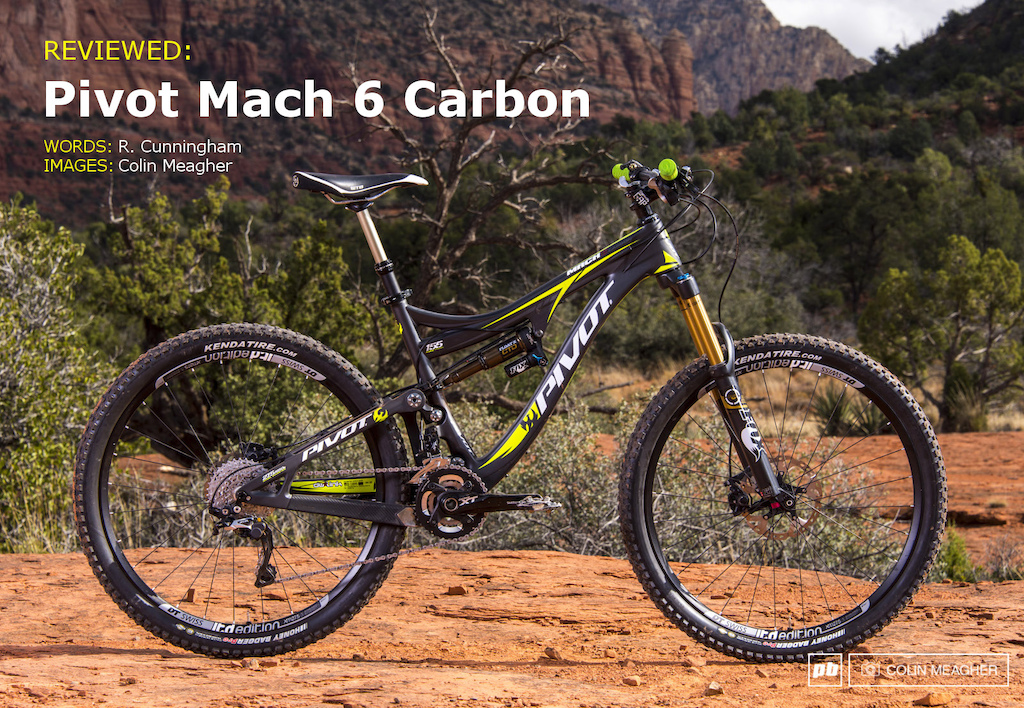


 (clockwise) CNC-machined aluminum caps conceal double-row bearings that help keep the dw-link rockers free from side play. Note how the yoke captures the shock eyelet in the vertical plane. Pivot installs a plastic sag meter to assist in setting up the shock pressure. The gauge sits at about 30-percent of the shock stroke. Fox finally got its Float 34 fork set to rock and roll and it is well suited to the Mach 6. Another look at the shock yoke shows that it pivots from a different location than the rocker link, perhaps to modify the leverage rate of the suspension.
(clockwise) CNC-machined aluminum caps conceal double-row bearings that help keep the dw-link rockers free from side play. Note how the yoke captures the shock eyelet in the vertical plane. Pivot installs a plastic sag meter to assist in setting up the shock pressure. The gauge sits at about 30-percent of the shock stroke. Fox finally got its Float 34 fork set to rock and roll and it is well suited to the Mach 6. Another look at the shock yoke shows that it pivots from a different location than the rocker link, perhaps to modify the leverage rate of the suspension.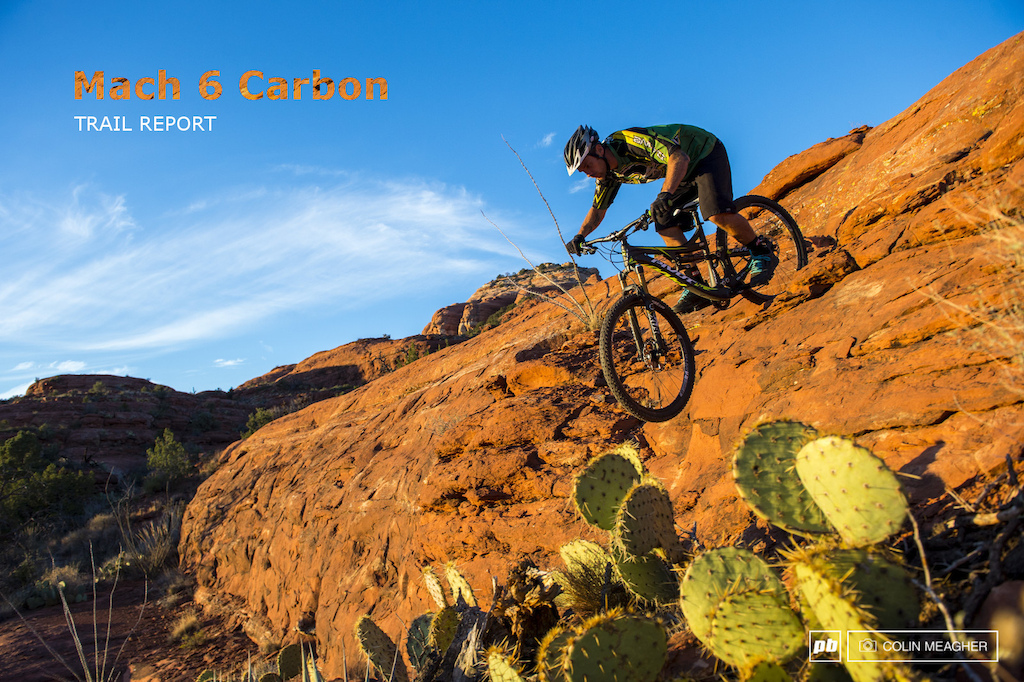
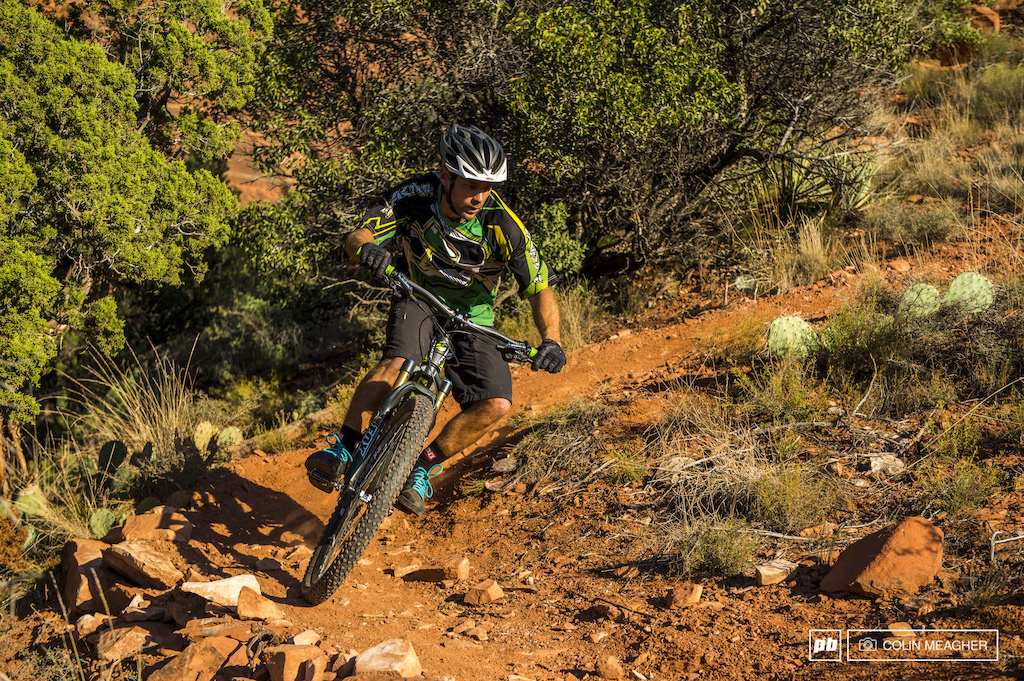


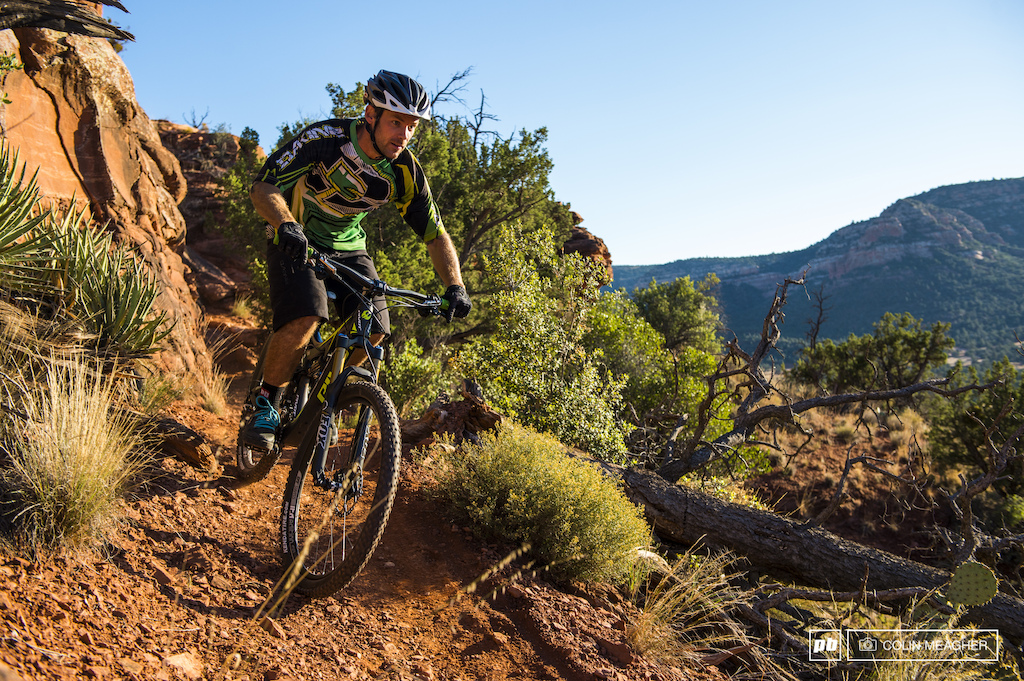
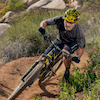
 Member since Mar 23, 2011
Member since Mar 23, 2011
Maybe one of the Power Rangers actors bought into Pivot and is working in the art department?
by 2016 we will all be rocking 65* all mountain bikes looking back saying what the hell were we thinking with 67*
I personally value those steep seat angle though, no mater the bike (DH excluded of course) and you can't really get around that with the current trend of bikes with longer reach, otherwise you'd be way to stretched in sit position. But the readability of those angles is quite confuse with more and more bikes sporting a kinked seat tube, or just an offset like the Pivot above. Some manufacturers provide you with Actual and Effective seat angle but I always have the feeling the Effective seat angle is measured at a ridiculously low saddle height.
All joking aside… Tolerance my friends, tolerance. The heart likes what the heart likes...
I love this bike. I plan to buy it something pretty for Valentine's Day.
Any day on any bike is better than a day at the office, I'm just saying...
You only have to be on Pinkbike for around 35 second to realise that we are all just a couple of old hens sitting around having a bitch and a gossip.
What fork travel have you found to work best with Mach 6? and is stock geometry based on 150 or 160 fork? Looking at the M6 and it's intent of trail/AM shredder, I think it would benefit from steepening it a bit 0.5-1* front and back and lowering about 1/4". I recently demo'ed a Troy with this geometry and did well under aggro trail/AM riding, but even feft the front end needed to be dropped even more due to bigger wheels for optimum up/down trail traction and shred, but it did have a taller HT and bar height (at least an 1" higher than what I am used to). Thanks!
It's always nice to get insight on how things are done, but basically this things should be written by an engineer.
And it's not the first bike to be made from carbon fiber right away. Example: Evil Uprising.
As for the liquifying question I totally understood what RC meant but I'm sorry, that's not what he wrote. If you make a description make it real and clear, or avoid it.
Still, I'm very interested in swinging a leg over this wonder especially after having been so impressed by the pedaling ability of the Mach 5.5 that I found equally as impressive in terms of discomfort. This one seems more balanced.
en.wikipedia.org/wiki/Catalyze
oald8.oxfordlearnersdictionaries.com/dictionary/catalyse
Now as nobody cares about chemistry or the appropriate use of english verbs, let's talk about BIKES!
In the article it is mentioned the KS LEV constantly crept down, and you say this is a known problem (nice they still sell them meanwhile BTW). My question is whether this is exclusively a problem concerning the Integra version or all of the KS LEV? Thanks for your reply (and your patience with my comments
Catalyze
Cat a lyze
Cats are Lazy
So there you have it, simple when you know how. And I can prove it because my cat sits around doing f*ck all all day getting fat especially when she is stored outside in freezing temperatures.
Has that helped?
The forks on the other hand, well now Ive got a new Pike, I cant see a single reason to go back to Fox, fair enough if it comes specced on a new bike but my Pike is superb - sealing on the RS forks is fine, the wettest winter in 250 years here in the UK and they are spotless inside, so thats not a worry, performance is excellent, nice and light, very stiff so that just leaves 2 things, price and looks, well the black stanchions on the pike are a win for me seem very hard wearing and look much better than the fox kashima/snakeoil colour and then theres price- Pikes are 25% cheaper than the Fox, its a no brainer.
Oh yeah the Pivot looks and sounds ace- though mud clearance ?
still a nice shock!
vimeo.com/85056372
The major change with the Mach 6 is the changed leverage ratio curve (as well as the special shock tuning). The notable effect is that there is more escalation in the wheel rate in the latter portion of travel. This allows the rear suspension to benefit from a good ramp up deeper in travel while remaining quite sensitive around SAG. The older LR curve had little escalation and high performance results required the use of shocks capable of a good ramp (e.g. the DB) and effective fine grained tuning. The sensitivity referred to by the writer was a consequence of leverage rate design not anti-squat. The leverage rate issue moreover seems to have been resolved on this new bike.
Kinda like comparing a 100mm underfoot ski to a 110 underfoot ( it is ski season afterall... ).
Love it and agree wholeheartedly.
"Bad - We'll take a lot of heat for writing good things about the 2014 versions from riders who remember the poor performance of the original Fox CTD suspension."
Good to hear they've improved it, I've yet to get trail time on a new model but I had no doubts. And i wouldn;t worry too much about the opinions of people who rode the 2013 stuff... id be more concerned about the people who didn't but then stumbled along following the 'trend'.
???
Stack and reach affect the attack position feel, not the top tube length. Slackening the seat tube to create more top tube behind the BB isnt going to affect the feel of the attack postion.
I purposefully only glanced at this to avoid being bummed that I can't have it. Take that, world.
This is worthless!
I'm seriously looking at buying one of these, but this review tells me absolutely nothing. "Its amazing!" Yeah, well so is pretty much every other bike on the market these days, that doesn't mean they're right for me.
IMO Bronson.
I was thinking of running the bronson with float x. Iv done a lot of DH however Doing a lot of all mountain now with location change. Which would you think?
Maybe bro ovr kona until kona is carbon (maybe). Range has been worst climber, but I havnt seen review w/1x in 42gear etc. (Also has 160rear too)
www.youtube.com/watch?v=mtrtDTp1g5Q
a href="http://www.go-ride.com/product/shimano-bb91-a-bb91-equivalent-press-fit-mtb-bottom-bracket-2460.htm">PF BB/a>
www.go-ride.com/product/shimano-bb91-a-bb91-equivalent-press-fit-mtb-bottom-bracket-2460.htm
I wish they would have shorted the CS and lengthen the front center on the Heckler a little…no constraints with the design. Clearly they were riding the coat tails of the Bronson's success, making it a lower cost alternative.
Firebird
Come on, I know that a combination of black and lime green looks cool, but show us some creativity...
O ya pinkbikes all enduro.